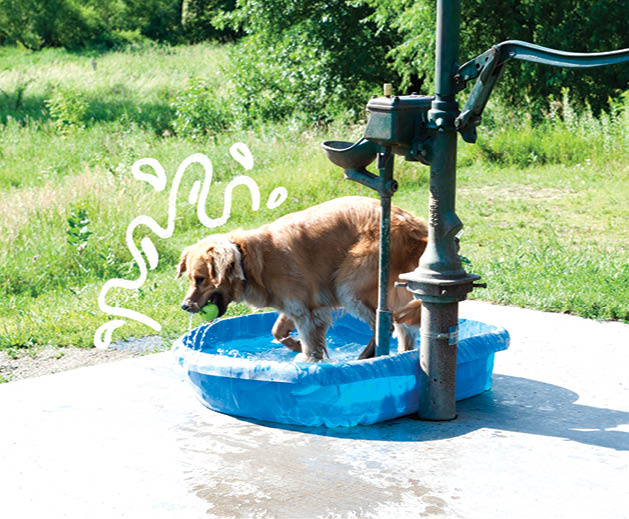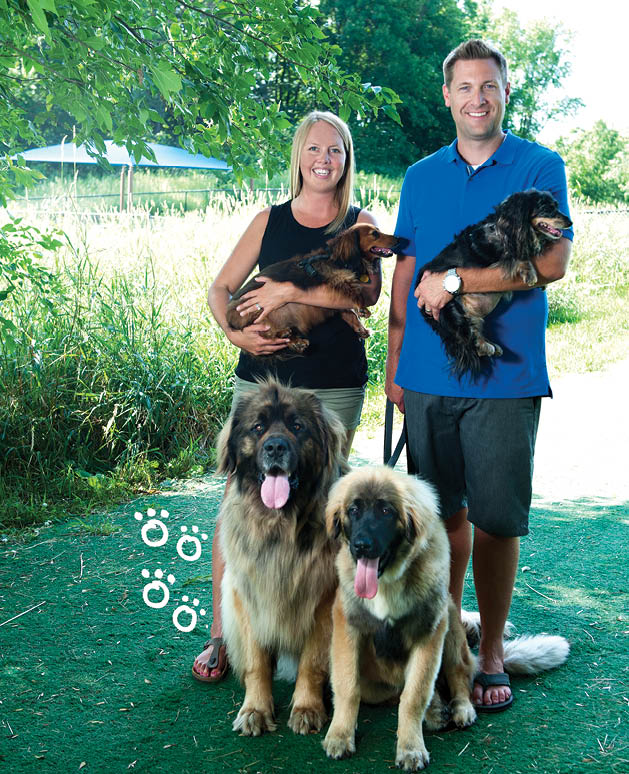Dog parks are social affairs for both humans and canines. The open space provides fresh-air opportunity for dogs to frolic freely while serving as common grounds for community members to connect. Drawing dog owners from all walks of life, dog park users share at least one thing: a great love for dogs.
Of the three dog parks located in Plymouth, the Plymouth Dog Park is the city’s original and largest park. Spanning 20 acres, it is well-loved by residents. In addition to mowed-in trails, separate areas for large and small dogs, a shelter area, benches and water for both dogs and humans, the park offers agility courses with equipment including tubes for dogs to run through, ramping and agility poles. “We’ve done a lot of work in that area to try to make it more welcoming and pleasing to the dogs and dog owners,” deputy director of parks and recreation Barb Northway says. The park even has a Facebook page for users to stay connected. “Obviously going to a dog park has become as much of a social thing for dogs as it is for their owners.”
Because of Plymouth dog park’s popularity, the city added two additional sites: the year-round 4 Paws dog park and the seasonal Happy Tails dog park. The parks, which are open daily from dawn to dusk, see a lot of foot and paw traffic. Northway has seen all kinds of dogs at the parks, everything from little toy dogs to Great Danes. Dogs of all ages come to play, too. There’s a complete list of park etiquette and rules and regulations listed on the city’s website. However, Northway says the two essential rules are picking up after your dog and leashing your dog upon exiting the park.
“I think it’s great for dogs to have a chance to play and socialize,” Sara Williams, DVM, MPH of Northwest Animal Hospital, says about the benefits of parks for dogs. “It’s fun to see how normal dog behavior is. They are very different when they are in a pack versus what we see at home. It’s fun to watch them communicate.” In addition to the mental stimulation dogs receive at the parks, there’s the added benefit of exercise. Williams says that one of the biggest issues she sees at her practice is obesity in dogs from lack of exercise.
Your dog might love to run wild at the parks, but not all dogs are suited for the environment. Williams advises against bringing puppies that are too young because they are more prone to catching certain diseases. Dogs should stay away from the parks until they are fully vaccinated, which typically is when a puppy is 4–5 months old. Also, some dogs don’t interact well with other dogs, especially bigger dogs or ones they don’t know. If your dog doesn’t get along with other dogs, don’t bring it to the dog park. Instead, Williams advises doing socializing and counter conditioning with a trainer.
“There are a lot of unknowns at dog parks,” Williams says. “It’s important to know your dog and know how they will respond before you put them in that situation.” Mastering basic obedience training—sit, stay, come—is highly important. There are a few other tips Williams shares with her clients: Bring your own water bowl, because communal water bowls are prime places for spreading parasites and contagious diseases. Flea and tick prevention is very important at parks because you don’t know the other dogs there. And ideally your dog should be identified with both a microchip and a dog collar in case it escapes the park.
Dogs aren’t the only ones that benefit from the parks; the parks serve dog owners as well. Read on to learn more about what three local dog park regulars enjoy about having these parks.

Erika Wehmhoff and her 2-year-old German Shepherd Odin are regulars at the Happy Tails dog park. Wehmhoff, a scientific recruiter who was born and raised in Plymouth, estimates they go to the park five to seven times per week, although she admits that estimate is conservative.
Odin is a playful pup who loves his Frisbee. When he arrives at the Happy Tails parking lot, he excitedly jumps from the car, Frisbee in mouth. Wehmhoff likes Oakwood park’s site for its wide open space to play fetch safely. “For Odin, he can catch Frisbees and I don’t have to worry about him running away.” Others like the park for this aspect, too. Wehmhoff sees most park user regulars bring some sort of throwing toy with them when they go.
Wehmhoff also appreciates the park’s social aspect for herself. “You meet people that you wouldn’t ordinarily come across,” Wehmhoff says, noting that she’s met people from all different backgrounds, age groups and professions. Surprisingly, she rarely runs into these people anywhere away from the park: “The dog is the great unifier.”

When Jessica Engebretsen says “dog park” to her 2-year-old golden retriever Bailey, she knows exactly where they are going: the Plymouth Dog Park. On the drive to the park, Bailey hangs her head outside of the window and wags her tail excitedly as they reach that familiar destination. The duo goes daily on weekdays and twice on the weekends.
The Plymouth dog park is a big part of Engebretsen’s life; she works as an office assistant for Thrivent Financial. “Personally, I enjoy it just as much as the dogs do,” Engebretsen says. “I’ve actually met some lifelong friends at the dog park.” Engebretsen sees a group of seven dog owners daily who are regulars just like her, showing up to the park at the same time each day, rain or shine.
Bailey has made dog and human friends, but Engebretsen always remains her favorite. The two share a special bond. “Bailey is my family,” Engebretsen says. “If I am having a bad day, she will be right there with me.” One day, Engebretsen hopes to train Bailey to be a therapy dog to help students with special needs.
Brian and Julie Walerius have always been dog people. Together, this married couple has four dogs: Macy (age 11) and Riley (age 9) are long haired miniature dachshunds; Bargas (age 3) and Feldman (still a pup under a year) are leonbergers. The Waleriuses have lived in Plymouth for seven years. Brian Walerius works as VP of product development at Total Expert and Julie Walerius stays home with the dogs.
Walking four dogs is a commitment. Leashes are bound to tangle. When the Waleriuses take all of their canines to the Plymouth Dog Park a few times per week, it’s a relief to unleash their animals. “They all kind of have different interests,” Julie Walerius says of her dogs at the park. The little dogs love people and like to go for attention; the big dogs like to play and run. “It’s a great way for them to get all the exercise they need. They all go home tired, which is the best part.”
Like so many of the frequent dog park users, the Waleriuses are part of the community: “Especially with the Plymouth dog park, there are a lot of the regulars there that you get to know,” Julie Walerius says. “Usually you don’t know their name, but you know their dog.”










